How to Wire Twin Timer in Repeat Cycle and One-Shot Mode for 120V/240V Motors?
A digital twin timer can be wired and configured for repeat cycle (ON-delay or OFF-delay) and one-shot operations. In our previous wiring guides, we discussed one-shot operation and repeated ON-delay cycles using a twin timer. In today’s post, we will show how to control a 120V or 240V pump motor with the help of a contactor in repeat cycle mode using a digital twin timer.
One Shot Operation:
In this mode, the timer’s circuit can be wired for a single operation, i.e., when you configure the circuit, it will operate (either ON or OFF the circuit) permanently. If you want to configure the circuit for a second operation, you will have to reset the timer circuit by disconnecting the 120V or 240V supply to the timer terminals (9 and 10). Alternatively, you may reset the timer to the initial state by momentarily connecting and disconnecting terminals 4 and 3 (reset) of the timer.
ON-Delay Operation
The 120V or 240V single phase power supply is connected to the 9 and 10 terminals of twin timer. When the timer activates and begins counting, the Normally Closed (NC) terminal # 6 is remain OFF until the preset time expires (and then turns-ON). It remains ON until the power supply is disconnected to the timer.
OFF-Delay Operation
When the power supply is connected to the twin timer and it turns ON, the Normally Open (NO) terminal turns ON and remains OFF until the power supply is disconnected to the timer. The mechanism can be controlled using an NC (normally closed) push button i.e. the pushbutton can be pressed to start the delay time circuit.
Related Posts:
- How to Wire Twin Timer for 120V/240V Circuits – ON/OFF Delay
- How to Wire Twin Timer for Repeated ON-Delay in Cycle Mode?
Repeat Cycle Operation:
In this wiring configuration, the circuit’s operation can be repeated continuously, for example, turning ON and OFF. The (on-delay or off-delay) circuit is designed for multiple operations while setting up the configuration and providing power supply only once. The entire circuit can be reinstated to the initial stage by disconnecting the power supply to the timer’s circuit.
Repeated Cycle Modes:
The repeated cycle mode can be configured for both ON-Delay and OFF-Delay, similar to the process outlined above for one-shot operation.
ON-Delay Mode: Delays the Switching-ON operation, where the motor does not operate immediately but turns on later after a specified time period.
OFF-Delay Mode: Delays the Switching-OFF operation, where the motor does not switch off immediately but turns off later after the predefined time period in the timer expires.
As illustrated, the power supply (either 120V or 240V, depending on the circuit requirements) is connected to the coil terminals (9 and 10) of the twin timer.
When the twin timer is ON and starts counting, it activates the contactor and turns ON the motor. After the predefined time period expires, it switches off the circuit, thus turning off the motor. The repeated cycle for ON and OFF operation (based on OFF-delay or On-Delay) continues until the power supply to the twin timer is disconnected or, conversely, by connecting and disconnecting the 3 and 4 terminals of the digital twin timer. If done so, the timer will reset and return to its initial state.
Related Posts:
- How to Wire One-Shot Timer using Twin Timer For Delay?
- How to Wire Twin Timer with Photo Eye Circuit for Time Delay?
Modification in the Circuit:
You can enhance the circuit by incorporating an additional timer or photo-eye on the incoming power supply lines to provide extra features, such as controlling the water pump during the day.
Additionally, consider integrating a rain sensor with a relay on the incoming power supply lines to the circuit. This ensures that the irrigation motor won’t start after rainfall.
- In 120V circuits, a 1/2 hp motor can be controlled using the twin timer.
- In 240V circuits, a 3/4 hp motor can be wired with the digital twin timer.
- The twin timer can handle up to 10 amps in an OFF-delay circuit.
- It can be set up to operate between 0.01 seconds to 99 hours and 99 seconds.
- A relay or contactor is recommended for use in high amperage circuits, such as motors, water heaters, ventilation fan, poultry fan, irrigation water pump etc.
Related Posts:
- How to Toggle between Two Heat Pumps using 240V Twin Timer?
- How to Toggle Electric Water Heater Between 120V and 240V?
- How to Control 120V & 240V Water Heater using ST01 Timer and Contactors?
- How to Wire ST01 Timer with Relay & Contactor for 120V/240V Motors?
- How to Reduce Runtime of Air-Conditioner During Peak Hours?
- How to Wire Multifunction ON/OFF Delay Timer for 120V/240V Motors?
- How to Wire ON-Delay Timer for 120V and 240V Load Circuits?
- How to Wire OFF-Delay Timer for 120V and 240V Load Circuits?
- Difference Between ON Delay and OFF Delay Timer
- How to Wire ON/OFF Delay Timer for AC & DC Loads – 230V & 24VDC
- Automatic & Manual Control of 3-Phase Motor Using Delay Timer
- Automatic ON/OFF Circuit Using Two 8-PIN Timers for 1 & 3-Φ Load
- How to Wire AH3 OFF-Delay Timer and Relay with Boiler Fan?
- How to Reverse Operation of Photo Eye using ST01 Timer?
- How to Wire ST01 Timer for Dusk-Dawn On-Delay Light Control?
- How to Wire Spring Wound Timer with LYS Rely for ON/OFF Delay
- How to Wire Remote Control Countdown Timer?

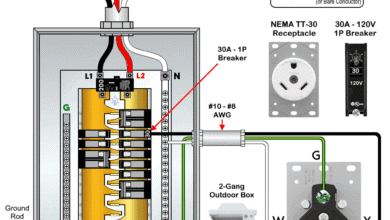 How to Wire NEMA TT-30 Receptacle for RVs & Travel Trailers
How to Wire NEMA TT-30 Receptacle for RVs & Travel Trailers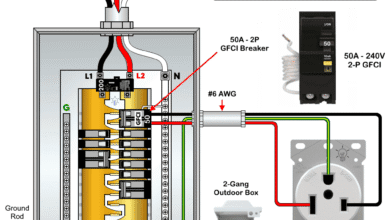 How to Wire a 50A – 250V, NEMA 6-50 Receptacle
How to Wire a 50A – 250V, NEMA 6-50 Receptacle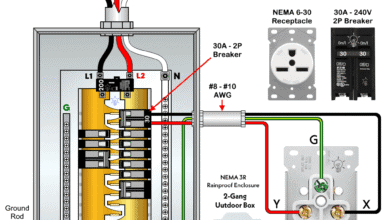 How to Wire a 30A – 250V, NEMA 6-30 Receptacle
How to Wire a 30A – 250V, NEMA 6-30 Receptacle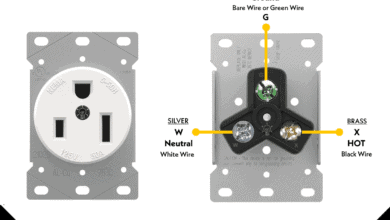 How to Wire a 50A – 125V – NEMA 5-50 Receptacle
How to Wire a 50A – 125V – NEMA 5-50 Receptacle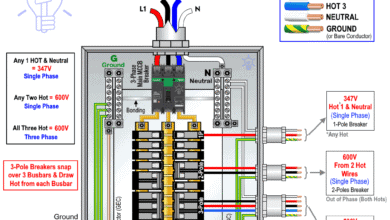 How to Wire 600/347V, 1-Phase & 3-Phase Main Service Panel
How to Wire 600/347V, 1-Phase & 3-Phase Main Service Panel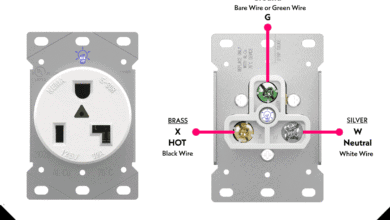 How to Wire a 30A – 125V – NEMA 5-30 Receptacle
How to Wire a 30A – 125V – NEMA 5-30 Receptacle